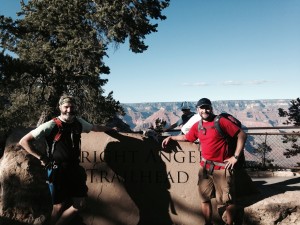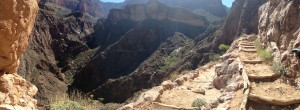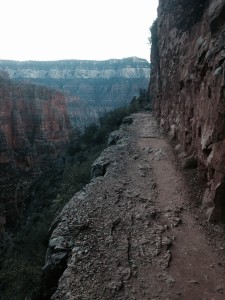15
How do we use vision to control the placement of our feet on rough terrain, to avoid spraining that ankle? How do anxiety, fear and fatigue change the way we perform these activities? What differs between elite and novice climbers? Did I survive a rim to rim hike in the Grand Canyon? Let’s hit the trail….
Download link



Key points:
• When hiking over rough terrain out leg movements are planned 2-3 steps ahead of time by changing the placement and force of our feet
• When vision is restricted and we can’t see far ahead we must make corrections mid-stride which are less efficient and prone to error (i.e., falling or stepping on an obstacle)
• The degrees of freedom (df) problem in movement is that fact that there are multiple different combinations of joint and muscle responses that can produce the same outcome (e.g., placing fingers on a hand hold while climbing). How does a performer choose?
• Bernstein (1967) proposed that this problem can be solved by freezing the df in movement, that is, coupling the movement of particular joints and limbs (so they move together). This simplifies the action but results in very non-fluent movement. He further proposed that with experience a performer can free the df to allow for a wide range of movement option.
• Bernstein also proposed that under anxiety of fear an experienced performer may revert from freeing to freezing, an idea which has been supported by research on rock climbing
• Climbers perception of the maximum distance they can reach seems to be reasonably well-calibrated with the actual distance, in particular when they are fatigued
• The specificity of practice rules seems to apply when using anxiety conditions during practice. That is, performers trained under low anxiety conditions perform well when tested under low anxiety but poorly when tested under high anxiety. Conversely, performers trained under high anxiety show the opposite pattern. The best practical solution seem to be to mix different levels of anxiety during training.
• Experienced hikers have better memory for trail scenes (in particular one’s of high difficulty) likely due to their ability to chunk information
Articles:
Visual control of foot placement when walking over complex terrain
Anxiety–performance relationships in climbing: a process-oriented approach
Anxiety-induced changes in movement behaviour during the execution of a complex whole-body task
Changes in the perception of action possibilities while climbing to fatigue on a climbing wall
Practice with anxiety improves performance, but only when anxious: evidence for the specificity of practice hypothesis
Short report: the effect of expertise in hiking on recognition memory for mountain scenes
More information:
My Research Gate Page (pdfs of my articles)
My ASU Web page
Podcast Facebook page (videos, pics, etc)
Twitter: @Shakeywaits
Email: robgray@asu.edu
Credits:
The Flamin’ Groovies – Shake Some Action
Closely Watched Trains – Hills Climb
The Spectacular Fantastic – Echo Mountain
Arsonist – Hot Salsa Trip\
Johnny Weltraum – Blackout
Karmafish – Dusty Trail
via freemusicarchive.org and jamendo.com
